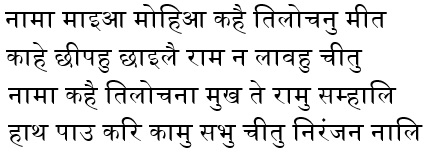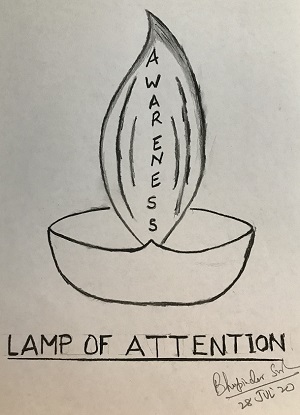Nov 08, 2025
Nov 08, 2025

Naamaa maiaa mohiaa kahai Trilochan meet.
Kaahe chheepahu chhailai raam na laavahu cheet.
Naamaa kahai Trilochanaa mukh te raam sa(n)m(h)aal.
Haath paau kar kaam sabh cheet nira(n)jan naal
—— (SGGS, Pg. 1375)
Translation:
Trilochan says, O Namdev,
the material world (maya) has enticed you, my friend.
Why are you busy printing designs on these sheets,
and not focusing your consciousness on God?
Namdev answers,
O Trilochan, say God's Name with your mouth.
With your hands and feet, do all your work,
but let your consciousness remain with God.
My Understanding
 Here, Kabir Ji has captured the conversation between two saints Bhagats Trilochan and Namdev in Maharashtra. This conversation took place when Trilochan Ji visited Namdev Ji in latter’s place. Although Kabir, a Banaras resident born about 128 years after Namdev and living hundreds of miles away was aware of this incident and captured it with his pen when there were no established methods of communication or transfer of information. As we can see here, Bhagat Trilochan was shocked to find Namdev engaged in pursuit of money, utilizing his training as a calico printer. Trilochan asked a very pointed question as to why he was engaged in such futile pursuits. Trilochan added that instead he should be focusing his attention on God.
Here, Kabir Ji has captured the conversation between two saints Bhagats Trilochan and Namdev in Maharashtra. This conversation took place when Trilochan Ji visited Namdev Ji in latter’s place. Although Kabir, a Banaras resident born about 128 years after Namdev and living hundreds of miles away was aware of this incident and captured it with his pen when there were no established methods of communication or transfer of information. As we can see here, Bhagat Trilochan was shocked to find Namdev engaged in pursuit of money, utilizing his training as a calico printer. Trilochan asked a very pointed question as to why he was engaged in such futile pursuits. Trilochan added that instead he should be focusing his attention on God.
Obviously we can feel that Trilochan was shocked to see Namdev not engaged in meditation. It is like that moment “what are you doing”? Namdev shot back that it is alright to work with hands and feet, while tongue is engaged in remembrance of God. Here Namdev Ji has shared a crucial insight about where consciousness or awareness should be focused on. Many a times in life we are physically engaged in an activity but our mind is somewhere else, in La-La land. Here Namdev has emphasized where the awareness should be focused on, while the hands and feet are engaged in work.
The words above do not provide the details of Namdev Ji’s response, but we have the details of the response available so let us look at them for additional clarity.
Bhagat Namdev’s replies in his own words as captured in Guru Granth Sahib are as follows:
“Aaneele kaagadh kaaTeele gooddee aakaas madhe bharameeale.
Pa(n)ch janaa siau baat batuooaa cheetu su ddoree raakheeale.1.
Mun raam naamaa bedheeale. Jaise kanik kalaa chit maa(n)ddeeale.1. Rahaau.
Aaneele ku(n)bh bharaieele uoodhak raaj kuaar pura(n)dhare'e.
Hasat binodh beechaar karatee hai cheetu su gaagar raakheeale.2.
Mandhar ek dhuaar dhas jaa ke guoo charaavan chhaaddeeale.
Paa(n)ch kos par guoo charaavat cheetu su bachharaa raakheeale.3.
Kahat naamadheau sunahu tilochan baalak paalan pauddeeale.
Antar baahar kaaj biroodhee cheetu su baarik raakheeale. 4.1.”
—— (SGGS, Pg. 972)
Translation:
(O Trilochan, as a boy) brings paper,
cuts it and makes a kite, and flies it in the sky,
keeps talking with his friends,
yet he keeps his attention on the string
(attached to the kite).1.
(O! Trilochan, my mind has been pierced by the Naam,
like the goldsmith,
whose attention is held by his work
(while talking to customers he is paying attention to gold
in the crucible atop a burning furnace).1. Pause.
(O Trilochan) The young girls in the city take pitcher (go outside the city),
fill it with water, laugh, play, and talk with friends,
yet keep their attention focused on the pitcher of water.2.
(O Trilochan) cows are let loose out of a mansion with ten gates,
to graze in the field.
Cows graze up to five miles away, but keep attention focused on calves
(similarly, my ten organs work to earn livelihood for the body,
yet my mind stays focused on God).3.
Says Namdev (I give you one more example), listen,
O Trilochan: the child is laid down in the cradle,
its mother works, inside and outside,
yet she holds her child in her thoughts.4.1.
The above answer, loaded with 5 practical illustrations from daily life, impressed Trilochan. He heeded the advice and incorporated it in his daily routine. After the visit with Bhagat Namdev, Trilochan returned back to his village and started serving religious mendicants, who came that way taking a leaf again from Namdev Ji’s practices. Slowly, the daily meditation and service of religious men transformed Trilochan, and he too became enlightened.
So, the takeaway from this discussion between two spiritual souls is the significance of awareness. The true reality is that most of us go through our lives like a robot, without any awareness of what we are doing. Awareness, means living live every moment with consciousness of self and that is happening around. It is not an easy change to incorporate in life. This awareness will become an agent of change as it happened with Trilochan after his meeting with Namdev. So, living a life of awareness is quite challenging as it is means forgetting the past and the future. Yet in life we always live in the memories of the past or in the imagination of the future. However, becoming aware and living a life of awareness is living in present and it is a true virtue. The journey starts with becoming aware of the body, progressing to become aware of emotions, thoughts, feelings, moods. The ultimate progress is when individual awareness becomes aware of universal awareness and merges in it. Kabir Ji is trying to share with that aspect of the power of awareness.
July 27, 2020
The English translations are purposely done in more than normal lines for better clarity of the original verses.

|
Thanks Bhupinder ji for clarification. I hope in future you will add translation of more Dohas. Many Kabir dass ji has written in Bijak language, if you can add few of them here will be great help |

|
Ravi, One of the style that Kabir adopted was Dohas. But he has many more compositions in other meters. The first authentic collection of Kabir's compositions is in SGGS )Sri Guru Granth Sahib). This is way before Kabir's Beejak was printed. Where in the SGGS the compositions of Bhagats start there is a heading defining the author. As you can see I have mentioned the Page Nos. from SGGS. I hope this clears the issue and any other misgiving. |

|
Kabir Sahib used to write couplets, two line dohas. This is first time i have ready four lines Doha Is this written by Kabir? |